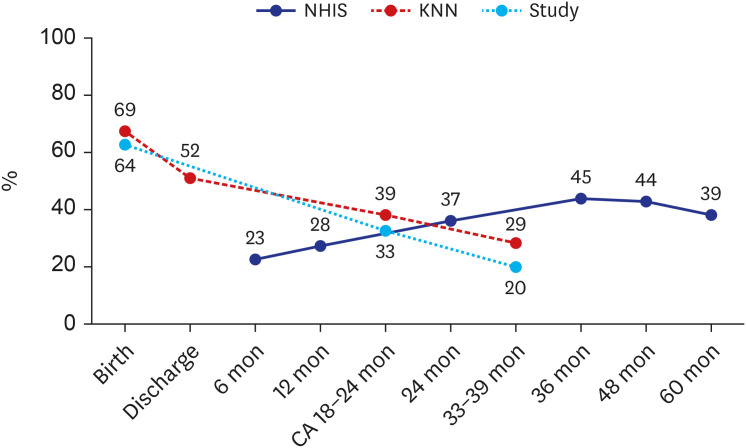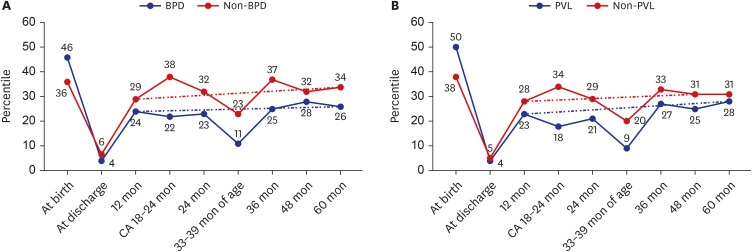J Korean Med Sci.
2022 May;37(20):e162. 10.3346/jkms.2022.37.e162.
Growth Pattern With Morbidities From Birth to 5 Years of Age in Very Low Birth Weight Infants: Comparison of the Korean National Network and National Health Insurance Service
- Affiliations
-
- 1Department of Pediatrics, Yonsei University College of Medicine, Seoul, Korea
- KMID: 2530105
- DOI: http://doi.org/10.3346/jkms.2022.37.e162
Abstract
- Background
Long-term growth data of very low birth weight (VLBW) infants are currently collected in the Korean Neonatal Network (KNN) and National Health Insurance Service (NHIS) database. However, variance in the number of infants, check-up time, and check-up parameters led to decreased credibility of cumulated data. We aimed to compare the data on serial growth outcomes by major morbidities from birth to 5 years in VLBW infants between the KNN and NHIS databases.
Methods
We combined the NHIS and KNN data of VLBW infants born between 2013 and 2015. The check-up times in the NHIS database were at 4–6, 9–12, 18–24, 30–36, 42–48, and 54–60 months of age, whereas in the KNN were at 18–24 months of corrected age and at 36 months of age. Result: Among 8,864 VLBW infants enrolled based on the birth certificates from the Statistics Korea, 6,086 infants (69%) were enrolled in the KNN, and 5,086 infants (57%) participated in the NHIS health check-up. Among 6,068 infants, 3,428 infants (56%) were enrolled at a corrected age of 18–24 months and 2,572 infants (42%) were enrolled at a chronological age of 33–36 months according to the KNN follow-up registry. However, based on the national birth statistics data, the overall follow-up rate of the KNN at 36 months of age was as low as 29%. The NHIS screening rate was lower at first (23%); however, it increased over time to exceed the KNN follow-up rate. Growth failure (weight under 10th percentile) at corrected ages of 18–24 months and 36 months were more common in the NHIS than KNN (42% vs. 20%, 37% vs. 34.5%). Infants with bronchopulmonary dysplasia and periventricular leukomalacia showed similar rates of growth failure at 2 years but varying rates at 3 years between the KNN and NHIS.
Conclusion
By integrating the KNN and NHIS data indirectly at continuous time points according to morbidities, we found that there are discontinuities and discrepancies between the two databases among VLBW infants. Establishing an integrated system by patient level linking the KNN and NHIS databases can lead to better understanding and improved neonatal outcomes in VLBW infants in Korea.
Keyword
Figure
Reference
-
1. Horbar JD, Carpenter JH, Badger GJ, Kenny MJ, Soll RF, Morrow KA, et al. Mortality and neonatal morbidity among infants 501 to 1500 grams from 2000 to 2009. Pediatrics. 2012; 129(6):1019–1026. PMID: 22614775.2. Hwang JH, Jung E, Lee BS, Kim EA, Kim KS. Survival and morbidities in infants with birth weight less than 500 g: a nationwide cohort study. J Korean Med Sci. 2021; 36(31):e206. PMID: 34402234.3. Stoltz Sjöström E, Öhlund I, Ahlsson F, Engström E, Fellman V, Hellström A, et al. Nutrient intakes independently affect growth in extremely preterm infants: results from a population-based study. Acta Paediatr. 2013; 102(11):1067–1074. PMID: 23855971.4. Ruth VA. Extrauterine growth restriction: a review of the literature. Neonatal Netw. 2008; 27(3):177–184. PMID: 18557265.5. Wang N, Zhang J, Yu Z, Tang B, Zhang L, Yin Y, et al. Evaluation of nutrition status of very preterm infants in neonatal intensive care units using different growth indicators. Nutr Clin Pract. 2021; 36(6):1312–1319. PMID: 34339517.6. Shah PS, Lui K, Sjörs G, Mirea L, Reichman B, Adams M, et al. Neonatal outcomes of very low birth weight and very preterm neonates: an international comparison. J Pediatr. 2016; 177:144–152.e6. PMID: 27233521.7. Shah PS, Lee SK, Lui K, Sjörs G, Mori R, Reichman B, et al. The International Network for Evaluating Outcomes of very low birth weight, very preterm neonates (iNeo): a protocol for collaborative comparisons of international health services for quality improvement in neonatal care. BMC Pediatr. 2014; 14(1):110. PMID: 24758585.8. Chang YS, Park HY, Park WS. The Korean Neonatal Network: An Overview. J Korean Med Sci. 2015; 30(Suppl 1):S3–11. PMID: 26566355.9. The Executive Committee of Korean Neonatal Network. 2017 Korean Neonatal Network Annual Report. Cheongju, Korea: Korean Centers for Disease Control and Prevention;2018.10. National Health Insurance Service. About us: history. Updated 2020. Accessed January 1, 2022. http://www.nhis.or.kr/static/html/wbd/g/a/wbdga0203.html .11. Yoon SJ, Lim J, Han JH, Shin JE, Lee SM, Eun HS, et al. Identification of growth patterns in low birth weight infants from birth to 5 years of age: nationwide Korean cohort study. Int J Environ Res Public Health. 2021; 18(3):1206. PMID: 33572910.12. Moon JS. Review of national health screening program for infant and children in Korea. J Korean Med Assoc. 2010; 53(5):377–385.13. Yang M, Ahn SY, Jo HS, Sung SI, Chang YS, Park WS. Korean Neonatal Network. Mortality and morbidities according to time of birth in extremely low birth weight infants. J Korean Med Sci. 2021; 36(13):e86. PMID: 33821593.14. Park HW, Park SY, Kim EA. Prediction of In-Hospital Mortality After 24 Hours in Very Low Birth Weight Infants. Pediatrics. 2021; 147(1):e2020004812. PMID: 33310907.15. Lee J, Lee JS, Park SH, Shin SA, Kim K. Cohort profile: the National Health Insurance Service-National Sample Cohort (NHIS-NSC), South Korea. Int J Epidemiol. 2017; 46(2):e15. PMID: 26822938.16. Lim J, Yoon SJ, Shin JE, Han JH, Lee SM, Eun HS, et al. Growth failure of very low birth weight infants during the first 3 years: a Korean neonatal network. PLoS One. 2021; 16(10):e0259080. PMID: 34710152.17. Han JH, Yoon SJ, Lim JH, Shin JE, Eun HS, Park MS, et al. The impact of neonatal morbidities on child growth and developmental outcomes in very low birth weight infants: a nationwide cohort study. Eur J Pediatr. 2022; 181(1):197–205. PMID: 34236516.18. National Health Insurance Service. Infants and children health checkup guide. Updated 2021. Accessed January 5, 2021. https://www.nhis.or.kr/nhis/healthin/wbhaca04800m01.do .19. Korean Statistical Information Service. Birth statistics. Updated 2022. Accessed January 1, 2022. http://www.kosis.kr .20. Korean Statistical Information Service. Statistical database. Updated 2022. Accessed January 1, 2022. https://kosis.kr/eng/ .21. Soleimani F, Zaheri F, Abdi F. Long-term neurodevelopmental outcomes after preterm birth. Iran Red Crescent Med J. 2014; 16(6):e17965. PMID: 25068052.22. Beam AL, Fried I, Palmer N, Agniel D, Brat G, Fox K, et al. Estimates of healthcare spending for preterm and low-birthweight infants in a commercially insured population: 2008-2016. J Perinatol. 2020; 40(7):1091–1099. PMID: 32103158.23. Horbar JD, Ehrenkranz RA, Badger GJ, Edwards EM, Morrow KA, Soll RF, et al. Weight growth velocity and postnatal growth failure in infants 501 to 1500 grams: 2000-2013. Pediatrics. 2015; 136(1):e84–e92. PMID: 26101360.24. Dusick AM, Poindexter BB, Ehrenkranz RA, Lemons JA. Growth failure in the preterm infant: can we catch up? Semin Perinatol. 2003; 27(4):302–310. PMID: 14510321.25. Abdallah Y, Namiiro F, Nankunda J, Mugalu J, Vaucher Y. Growth of preterm very low birth weight infants discharged with weight of less than 1500grams. BMC Pediatr. 2021; 21(1):145. PMID: 33765972.26. Guellec I, Lapillonne A, Marret S, Picaud JC, Mitanchez D, Charkaluk ML, et al. Effect of intra- and extrauterine growth on long-term neurologic outcomes of very preterm infants. J Pediatr. 2016; 175:93–99.e1. PMID: 27318373.27. Jeon GW. Changes in the incidence of bronchopulmonary dysplasia among preterm infants in a single center over 10 years. Neonatal Med. 2020; 27(1):1–7.28. Siffel C, Kistler KD, Lewis JF, Sarda SP. Global incidence of bronchopulmonary dysplasia among extremely preterm infants: a systematic literature review. J Matern Fetal Neonatal Med. 2021; 34(11):1721–1731. PMID: 31397199.29. Park HA, Hwang JH. The risk factors of periventricular leukomalacia among very low birth weight infants. Neonatal Med. 2020; 27(2):51–56.30. Jo HS, Cho KH, Cho SI, Song ES, Kim BI. Recent changes in the incidence of bronchopulmonary dysplasia among very-low-birth-weight infants in Korea. J Korean Med Sci. 2015; 30(Suppl 1):S81–S87. PMID: 26566362.
- Full Text Links
- Actions
-
Cited
- CITED
-
- Close
- Share
- Similar articles
-
- Statistics and Medical Cost of Preterm in Korea
- A statistical Observation on Growth Pattern of Low birth Weight infants
- Changes in birth rates of low birth weight and premature infants in Korea over the past 7 years
- Clinical Study of Prematurity and Low Birth Weight Infants
- The low birth weight rate in Korea





